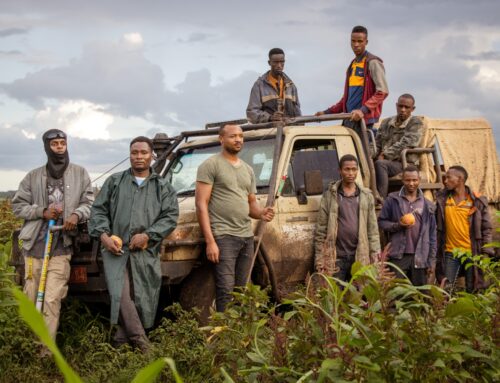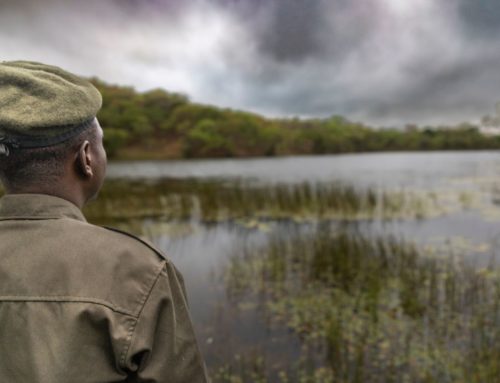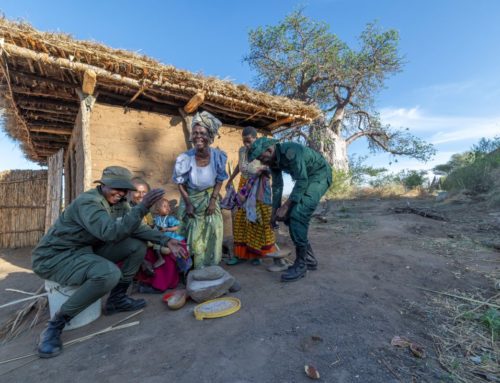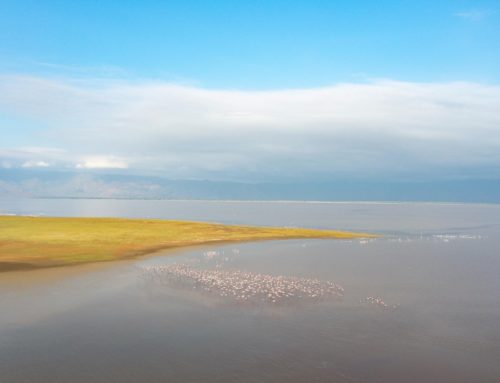From the air, the grey mass appeared like a hulking rock in the middle of the riverbed. But as he circled around the figure in his Microlight, Damian Bell knew immediately that the motionless mass below was a dead elephant, its tusks missing.
In the last days of December 2014, Bell, the executive director of both Honeyguide Foundation and Big Life Foundation in Tanzania, had been conducting aerial patrols over Manyara Ranch, a 35,000-acre conservation area managed jointly by the African Wildlife Foundation (AWF) and the Tanzania Land Conservation Trust (TLCT) in the heart of the Tarangire-Manyara ecosystem. Only the night before, Manyara Ranch’s rangers had heard gunshots. Due to heavy rains and darkness, however, their search efforts had gone in vain.
Even the following morning, after an elephant carcass was spotted from the air, the rangers had to trek on foot to the scene as the mud-slick roads made it impossible for vehicles to drive to the body. As it turned out, although the 30-year-old elephant had been shot, it could not be the victim of the gunshot heard the night before by the ranch’s rangers, as the body had considerably decomposed already.
“We knew there must be another body somewhere,” said Ezekiel Loserian, wildlife protection commander at Manyara Ranch. “It was the very first elephant killed here under our watch. We were not going to sleep until we found the poachers who did it.”
That’s when Loserian ventured into the mountains and the villages to meet with his elders.
Loserian and his men have a vast network of community informants who do not want to see poachers in their villages, killing wildlife and causing instability. Such individuals are the unnamed and unsung heroes in the fight against poaching, as the intelligence they provide can lead to more than 90% of arrests in community-based conservation areas.
Long past midnight, Loserian’s efforts had paid off. He had the names of two suspects, both notorious elephant poachers. He just needed to find them.
One step back
In the past decade, after coming under conservation management, Manyara Ranch has transitioned from a degraded cattle ranch to a haven for elephants, lions, giraffe, wildebeest and other wildlife moving between Tarangire and Lake Manyara National Parks.
“One can see three to four herds of elephants in Manyara Ranch in a day,” said Fidelis ole Kashe, the ranch manager. “The number of predators has increased, including lions, leopards, cheetahs, and even wild dogs. Animals find food, water, and peace here.”
In addition to AWF’s projects, Honeyguide, which partners closely with its cross-border counterpart, Big Life Foundation, in Kenya, has been managing wildlife protection efforts there for the past year and a half.
In previous years, more than 25 elephants might be lost to poachers in a year. Since coordinated wildlife protection operations began, however, no elephants had been poached within the ranch… until now seemingly.
Two steps forward
Less than a week after the rangers had first heard the gunshots, Loserian and his team called in and collaborated with government anti-poaching forces from Tanzania’s Wildlife Division. With additional intelligence, the men knew the location of the suspects’ hideouts. So they planned a pre-dawn ambush.
“One of them ran away out a backdoor as soon as we approached the place,” explained Loserian. “But he didn’t even make it 300 meters. The other one hid above the ceiling boards of another house. We could hear the bats up there flying around every time he made a move. We waited there beneath him all night until we were given permission by local authorities to cut him out of the ceiling and put him into custody.”
The suspects, both of whom had been sought by authorities for many years, later admitted to recently killing at least two elephants. As it turned out, the decomposing carcass first discovered by ranch rangers had been shot far outside the ranch in the Lesimingori Mountains and had lumbered onto the ranch to die.
While levels of elephant poaching in northern Tanzania remain modest when compared to those in the southern part of the country, the attack on an elephant roaming the Lesimingori Mountains was a reminder that gaps in protection remain, especially in the remote areas that lie beyond protected landscapes.
The rangers later found a second carcass, another young bull, which turned out to be the victim of the gunshots heard by rangers on that rainy December night. Because of the quick reaction and movements in the area by Loserian’s team, the poachers had fled before being able to hack out the bull’s tusks. These were eventually removed by the team and turned over to government authorities.
“These guys had been wanted for a long, long time,” said Loserian. “We are sad the elephants had to die but we have a great joy that we helped capture the poachers.”
That capture would have never been possible without the courageous efforts of community members fed up with poaching in their areas. Both Big Life and Honeyguide provide rewards and incentives for such informants and support community-based approaches to wildlife and resource protection.
The poachers have been formally charged for their alleged crimes and are currently awaiting trial.
Honeyguide manages the projects of Big Life in Tanzania. Honeyguide also receives support from such organizations as AWF, The Nature Conservancy, and USAID. Regional Air supports Honeyguide and Big Life and provides support for the Microlight in the Regional Air hanger in Arusha, Tanzania.







